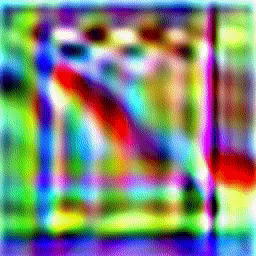Code Glyphs
This is an experiment that uses transformers (codeBERTa) and a convolutional neural network to learn visual representations of Python code. It can turn arbitrary Python code into a 128x128 RGB image. Of course, a similar system could be retrained on other programming languages, and probably natural language as well.
This is possible by designing the system as an autoencoder with a visual latent space. This is an unusual objective to force on a transformer, but with a low enough learning rate, it does manage to work. With the right hyperparameters, it took roughly a week to train on a TPUv3-8.
I'm using a few tricks to make this work, including perceptual loss and image augmentation. Much of the code to accomplish this is borrowed from an earlier project: Cooperative Communication Networks.
Dataset
The dataset is based on CodeSearchNet. After removing docstrings, every Python function with ≤128 tokens is kept. The final dataset is 213,298 Python functions.
Models
Language: codeBERTa is used twice. Once as a text encoder, and again as a text decoder (with a language modeling head.) A similar system in the future could probably benefit from an autoregressive decoder so it would probably look more like T5 or GPT.
Vision: A simple generative CNN is defined in generator.py. The decoder network (or "discriminator") is a pretrained ResNet-50 from BiT. This same network with its weights frozen is used for calculating perceptual loss (called perceptor in models.py).
Custom perceptual loss
Perceptual loss is used to encourage images to look different from each other, based on the pretrained weights from BiT. I found that a custom perceptual loss function gave better results: it encourages images to be as different as the latent vectors of the code that they represent. The code to do this is the vector_distance_loss function in models.py.
Credits
This project was made possible by the TensorFlow Research Cloud program. Thank you!!

